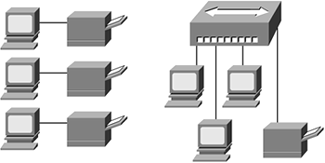Chapter 3. Local-Area Networking Introduction
What You Will Learn
On completing this chapter, you will be able to:
Describe local-area networks (LANs)
Explain the functions of wide-area networks (WANs)
Describe analog and digital signals
Compare characteristics of different network cabling types
Draw simple network topologies
List the different types of hardware found in a LAN or a WAN
Local-area networks (LANs) send and receive data at rates much faster than can be transmitted over a telephone line; but the distances are limited, often to a few hundred feet maximum without using costly, long-range technologies, such as Long Reach Ethernet (LRE) or wave-division multiplexing (WDM). Because of distance limitations, LANs are found in small areas such as a floor in your office building or a home network. LANs are used to connect personal computers (PCs), network workstations, routers to the Internet, and other network devices, such as network-capable printers, as illustrated in Figure 3-1.
Figure 3-1. Desktop/Printer Implementation Without a LAN and with a LAN, Respectively

Users connected via a LAN can chat and share files, Internet access, and printer access. The alternative to a LAN is for each user to have his own printer and Internet access.
Three characteristics differentiate one LAN from another:
LANs can be configured in different topologies. Topology is the geometric arrangement of devices on the network. For example, devices can be arranged in a continuous ring, where each computer is a link in the chain, or in a star, where each computer is connected to the same central device.
LANs follow different protocols, which are the rules and specifications for sending and receiving data.
LANs are connected through different media. For example, with LANs, the media through which a signal is transmitted among devices is twisted-pair wire, coaxial cable, fiber-optic cable, or wireless.
Several small LANs can be connected together to create a single larger LAN within a building. If your LANs are in offices across the country, these LANs use connections provided by a network service provider to create a wide-area network (WAN).






